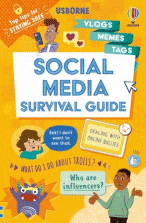
Social Media Survival Guide
Social Media Survival Guide
Holly Bathie
Usborne, 2022
304pp., pbk., RRP $A14.99
9781474999267
Like it or not, use it or not, social media is an integral of today’s life and despite it being illegal for those under 13 to have accounts because the Children’s Online Privacy Protection Act of 1998 (COPPA), which prevents collection and storage of personal information from children under 13 years of age which originated in the US but which is pretty much universal, many of our young students still access sites and apps daily.
For many parents, the world of social media and instant connectivity is not one in which they grew up – it’s all happened in the last 20 years – and so helping their children navigate where they never went when they were children can be tricky. Perhaps the recent hacking of Optus and Medicare and the exposure of personal date gathered legitimately can have a silver lining if it alerts parents to the spread of their digital footprint and propels them to start considering what they are sharing, and thus, their children.
For even though way back in 1996 my school had a huge focus on safe surfing of the web and the kids, most of whom did not have access to computers and the internet at home, had the basics drummed into them from the get-go, the issues caused by the use of these instant, anonymous platforms continue to rise as our young people seek attention, fame, and in some cases, notoriety. Who can forget the death of 14 year old Dolly Everett who took her own life because of online bullying.?
Thus this book which enables our young readers, even those under the required 13 years) to manage their life, relationships and mental health on social media platforms and empowers them to stay safe online is an important read for all. With the usual engaging layout we associate with Usborne, but in monochrome rather than colour, it offers in-depth coverage of a range of important a difficult issues young people face including body image, appearance-enhancing filters, influencers, sexual content and mental health. It uses recognisable themes rather than platform specifics, making the content relevant long-term, and tips on how to set up accounts safely and best manage privacy and messaging settings. It also addresses the user’s online persona, online reputation, and relationships; helps them understand fake news and information and how to handle online bullying, as well as avoiding trolls.
While social media can have a really positive side – many would have been very isolated without during COVID lockdowns – and it would be wonderful if we could instil such a sense of confidence and well-being in the younger generation that they never feel the need for anonymous, meaningless affirmation, nevertheless there is a dark side and users must be aware of the potential for harm as well as good. Once it’s out there, it’s out of your control.
As well as being an important guide for the kids, it is also really useful for parents themselves as they learn what it is their child needs to know and do, understand and value as what was once just “peer pressure” from your immediate social circle is now a universal phenomenon right there in their hand. It goes hand-in hand with the excellent site and work of the E-Safety Commissioner established by the Australian government which has information for everyone from parents to teachers to kids to women to seniors and even a host of diverse groups who may be targeted or marginalised.
Despite the care we take, every keystroke or finger tap can unknowingly add to our digital footprint, and so the better informed we are the safer we will be. Thus this is one to recommend to parents, to teachers and for yourself if you have responsibility for students or your own children online.